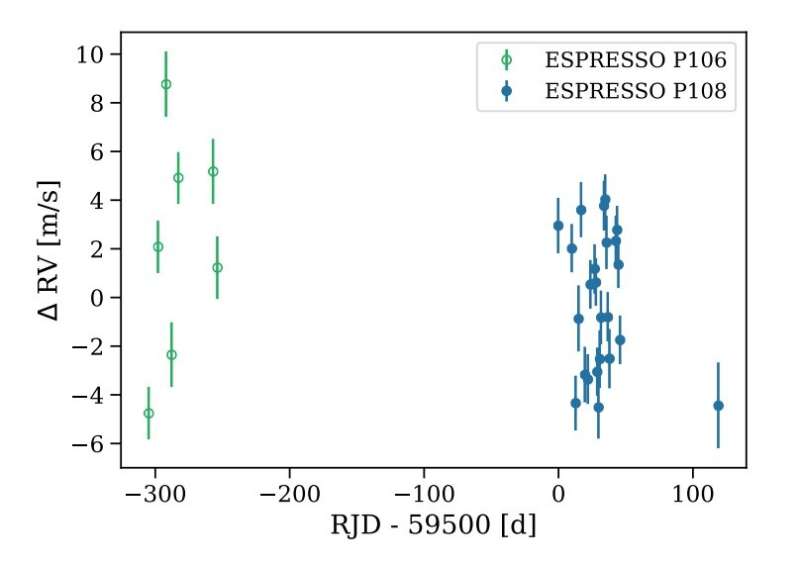November 1, 2022 report
New exoplanet detected with the ESPRESSO spectrograph

Tomasz Nowakowski
astronomy writer

Using the Echelle SPectrograph for Rocky Exoplanets and Stable Spectroscopic Observations (ESPRESSO), astronomers from Switzerland and Austria have discovered a new alien world. The newfound exoplanet orbits a nearby M dwarf star and is at least four times more massive than the Earth. The finding is reported in a paper published October 23 on arXiv.org.
ESPRESSO is the state-of-the-art ultra-stable high resolution spectrograph installed at the Very Large Telescope (VLT) in Chile, covering the spectral range from about 380 nm to 788 nm. The instrument is able to reach a precision allowing it to detect Earth-like planets around sun-like stars.
A team of astronomers led by Lia F. Sartori of the Swiss Federal Institute of Technology in Zürich, Switzerland, is conducting a blind ESPRESSO radial velocity search for planets around nearby stars. One of their targets was L 363-38—an M dwarf located some 33.3 light years away. They monitored this star between December 12, 2020 and February 08, 2022, obtaining a total of 31 observations, which resulted in the detection of a new planet.
"In the following we report the detection and characterization of a planet orbiting the nearby M dwarf star L 363-38. This is one of the few standalone planet discoveries with ESPRESSO so far," the researchers wrote in the paper.
The newly detected planet, designated L 363-38 b, has a minimum mass of about 4.67 Earth masses and its radius is estimated to be between 1.55 and 2.75 Earth radii. The exoplanet orbits its host every 8.78 days, at a distance of some 0.048 AU from it, therefore inside the inner edge of the habitable zone. The equilibrium temperature of L 363-38 b was calculated to be approximately 330 K.
The parent star L 363-38 (other designations: LHS 1134 and GJ 3049), estimated to be 8 billion years old, has a radius of about 0.274 solar radii and a mass of around 0.21 solar masses. The effective temperature of this star was measured to be 3129 K.
The astronomers suppose that L 363-38 may be orbited by some other planets that remain undetected. They explain that based on statistics from NASA's Kepler and TESS missions, planets around M dwarfs are expected to occur in multi-planet systems. Hence, follow-up observations of this planetary system with telescopes such as the James Webb Space Telescope (JWST), are required in order to uncover the presence of other extrasolar worlds around L 363-38.
In concluding remarks, the authors of the study demonstrates the potential of ESPRESSO in detecting and investigating exoplanets around nearby M dwarf stars.
"Indeed, the faintness of M stars makes them challenging targets for RV [radial velocity] studies using instruments like HARPS [High Accuracy Radial velocity Planet Searcher] behind a 3.6-m telescope, but a spectrograph behind an 8-m telescope like ESPRESSO can gather sufficient light to precisely measure their RV in an efficient manner," the researchers concluded.
Written for you by our author —this article is the result of careful human work. We rely on readers like you to keep independent science journalism alive. If this reporting matters to you, please consider a (especially monthly). You'll get an ad-free account as a thank-you.
More information: Lia F. Sartori et al, L 363-38 b: a planet newly discovered with ESPRESSO orbiting a nearby M dwarf star, arXiv (2022).
Journal information: arXiv
© 2022 Science X Network




















